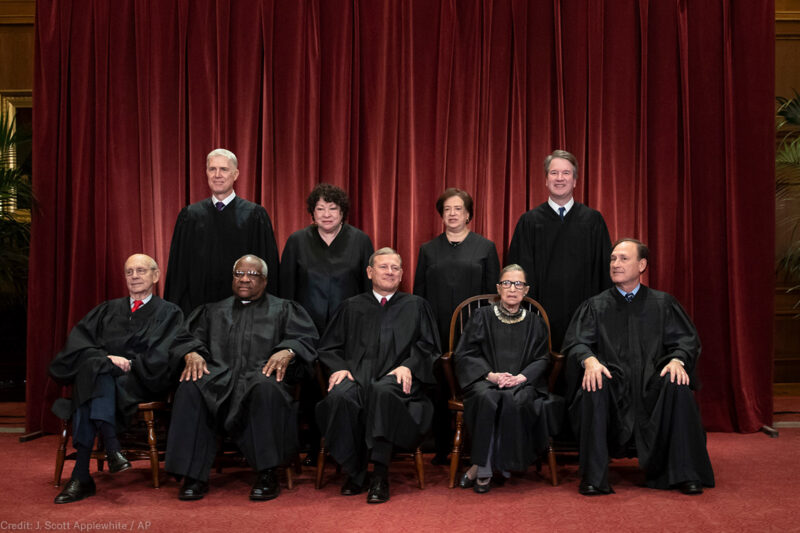In America, People on Death Row Can Be Executed While the Supreme Court Reviews Their Cases


Last month in Alabama, Domineque Ray was executed without the presence of his imam in the chamber. This, despite the fact that Christian chaplains are regularly present for executions. This, despite Rayโs compelling claim that his religious liberties were being violated. And this, despite the conservative 11th Circuitโs 28-page opinion how the state was blatantly trespassing upon the Establishment Clause.
So how โ despite these facts โ was Ray executed without an imam by his side? The answer lies in a single Supreme Court vote.
In Rayโs case, four justices voted to put the execution on pause while the lower court could hear his Establishment Clause claim, but this sizable minority was still insufficient. (The split was along party lines, with Kagan, Ginsburg, Sotomayor, and Breyer voting to stay, and Kavanaugh, Gorsuch, Roberts, Thomas, and Alito in the majority.) In Supreme Court cases, four votes are enough for the court to grant review, while five votes are required to stay a decision.
As Adam Liptak writes in The New York Times, these 5-4 votes present a โโ in death penalty cases, which make it โpossibleโฆ for a death row inmate to persuade the Court that his case is so important that it deserves to be [to be heard] โ but not so important that he shouldโฆ stay alive in the meantime.โ Indeed, given the different vote requirements, there have been cases in which the court agrees to consider the case after the prisoner is .
Justice, however, should not be rushed. The court must recognize that when it comes to life-or-death decisions, if four votes are good enough to hear the case, four votes are good enough to put an execution on hold until that case can be properly heard and litigated.
Historically, the court has on occasion addressed this problem in death penalty cases through the exercise of a โcourtesy fifth vote,โ by which a fifth justice who did not vote to grant review nonetheless voted for the stay of execution in order to ensure that the issue could be heard before the prisoner was killed. Justices exercised this practice even though it was clear from their votes against review that they didnโt agree with the caseโs merits.
But the courtโs approach to courtesy fifth votes is inconsistent, arbitrary, and unpredictable.
Take the case of Ronald B. Smith, who was executed in 2016, when the Supreme Court still had only eight members after Justice Antonin Scaliaโs death. Smithโs original jury voted to spare his life, but the judge overrode its verdict and sentenced him to die โ a practice (now outlawed) known as judicial override. At the Supreme Court level, โfour of the eight justices voted to his execution.โ Since none of the four justices voting against review supplied the courtesy fifth, the state of Alabama executed Smith. Only one month prior to Smithโs execution, Justice John Roberts supplied the โcourtesy fifthโ vote to stay the execution of a similarly situated inmate, Tommy Arthur.
Not only is the court inconsistent in its use of the courtesy fifth, its guidelines are clandestine. Time and again, the Supreme Court fails to illuminate how it arrives at a prisonerโs fate, offering little insight into how it reviews lower-court findings, when a โcourtesy fifthโ will be granted, and why it ultimately decides to deny a stay of execution. In sending Ray to the execution chamber last month, the Supreme Court offered only a single sentence of explanation in response to the lower courtโs 28 pages.
Eric Freedman, a Hofstra law professor, that without judicial transparency in capital cases, โindividuals live or die for reasons that are freakishly arbitrary and clouded in secrecy. That seriously damages the appearance and reality both of equal justice under law and of sound judicial decision-making.โ
In her of Rayโs execution, Justice Elena Kagan addressed the courtโs favoring of finality over justice:
โThe Eleventh Circuit wanted to hear [Rayโs] claim in full. Instead, this Court short-circuits that ordinary processโand itself rejects the claim with little briefing and no argumentโjust so the State can meet its preferred execution date.โ
It makes little sense that at the highest level, the court can decide whether someone lives or dies in a matter of hours without any clear consensus. As Justice Stevens once on the matter, โGreater โ surely not lesser โ care should be taken to avoid the risk of error when its consequences are irreversible.โ
If weโre going to live in a society that sanctions capital punishment, then the processes that determine whether someone dies must be fair, consistent, and clear to all, especially to those whose lives are at stake.


